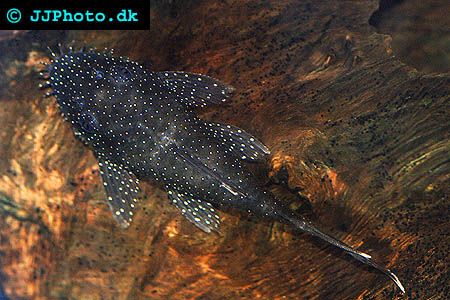Spawning Bristlenose Plecostamus (Ancistrus dolichopterus)
If you want to breed Bristlenose Plecostamus (Ancistrus dolichopterus), the least expensive way of obtaining a breeding couple is normally to purchase a group of young fish and let them grow up together. Bristlenose Plecos can not be sexed when they are young, but if you get a group the chances of getting a least one male and one female are pretty high. If you are think you're lucky, getting four specimens is enough. If not, get some more just to increase your chances of ending up with a compatible pair. As the Plecos grow bigger, the males will distinguish themselves from the females by growing bristles on their snouts.
Bristlenose Plecos will appreciate PVC tubes in the aquarium, both as hiding spots and spawning sites. It is also a good idea to include at least one peace of driftwood since this will provide future fry with suitable food.
Wild Bristlenose Plecos live in the upper and middle parts of the Brazilian Amazon River basin, and in the Negro, lower Trombetas, Tefé, Madeira and Tapajós River basins. In this environment, the pH-value can be 6.0 to 8.0 and the dH range is 5-19. The water temperature normally stays in the 23 – 27°C range. Captive kept Bristlenose Plecos are known to appreciate a neutral or slightly acidic pH-value, from pH 6.5 to 7.0. If you want to breed Bristlenose Plecostamus, it is advisable to use fairly soft water of 4-10 degrees General Hardness.
When the spawning has taken place, the PVC pipe will be filled with a cluster of yellow to orange eggs and the male will stay close to the eggs to protect them from hungry adult fish. The male will also fan fresh water over the eggs using his ventral and pectoral fins. As you can see, the male should absolutely not be removed from the aquarium after spawning.
When the eggs hatch, the fry will stay inside the tube and the male will continue to guard them. To begin with, the fry will look like a tiny ball with a wiggling tail and feed of its yolk sac for a few days. Investigative fry might wish to peek out of the tube, but the male will do his best to keep them inside where they are safer.
Eventually, the fry will leave the PVC tube and start swimming around. In addition to the drift wood, you should provide the fry with food by holding a piece of Romaine salad under hot water for a while before placing it in the aquarium. As they fry grow a bit bigger, you can start giving them newly hatched brine shrimp in addition to Romaine salad. You can now remove the male.
During the following weeks the fry will develop a darker colouration and become completely brown. Frequent water changes are imperative since the fry produces an impressive amount of waste products. Some fry might get sucked up if you use a siphon for water changes, but they will normally survive being sucked up as long as you promptly put them back into the aquarium.
When the Bristlenose Pleco fry has reached an age of two months they will hopefully be around ½ inch long (2.5 cm) and look like small versions of their parents.

Bistelnose catfish. Copyright www.jjphoto.dk
Didn't find the info you were looking for? Register for free and ask your question in our Aquarium forum or our Pleco forum !
Our knowledgeable staff usually responds to any question within 24 hours
Related Articles
Breeding Corydoras, Brochis and Aspidoras catfish - Secrets to the successful breeding of Corydoras, Brochis or Aspidoras catfishAlbino Catfish - Information about Albino Catfish
Biggest Catfish ever caught - Information about which is the Biggest Catfish ever caught
Blue Catfish - Information about Blue Catfish
Breeding Bristlenose catfish - Ancistrus species - How to breed Ancistrus
Breeding Corydoras barbatus, Banded Corydoras / Bearded catfish - An introduction to the species and how to breed it.
Breeding Corydoras davidsandsi - A guide to successfully breeding C davidsandsi.
Breeding Corydoras elegans - How to breed this dwarf Corydoras
Breeding Corydoras gossei - Detailed guide on how to breed C. gossei.
Breeding Corydoras melanotaenia - Information about how to keep and breed C melanotaenia
Breeding Corydoras nattereri - Guide to breeding Corydoras nattereri
Breeding Corydoras xinguensis - Information about how to keep and breed this beautiful fish..
Breeding Panda Catfish, Corydoras panda - Learn how to bread panda catfish.
Breeding Whiptails - Information about how to breed different kinds of whiptails.
Channel Catfish - Information about Channel Catfish
Flathead Catfish - Information about Flathead Catfish
Giant Mekong Catfish - Information about Giant Mekong Catfish
Huge Catfish - Information about Huge Catfish
Tatia perugiae - Driftwood Catfish - Perugia's Woodcatfish - An article about tatia prugiae.
Monster Catfish - Information about Monster Catfish
Breeding Synodontis multipunctatus - cuckoo catfish - A guide to keeping and breeding S. multipunctatus aka "cuckoo catfish"..
Jaguar catfish (Liosomadoras oncinus) - Information about how to keep and care for the jaguar catfish.
Tiger Shovelnose Catfish - Information about Tiger Shovelnose Catfish.
